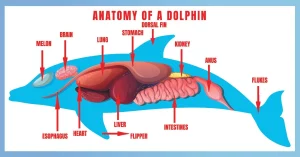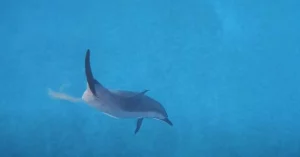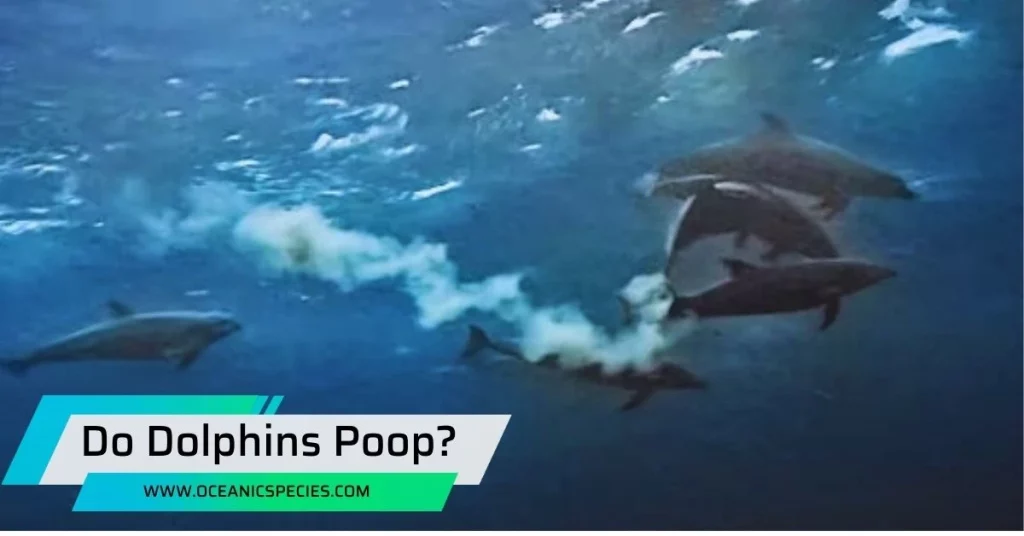Dolphins do poop through their anus or bladder, just like other mammals and cetacean species. They excrete waste, including toxic substances and non-nutrient matter, from their bodies.
Dolphins have two stomachs, with one storing food and the other for digestion. Their dorsal fins are unique and can be used for identification. While most dolphins live in saltwater, some thrive in freshwater environments.
The Anatomical Digestive System Of Dolphins
Dolphins, like other mammals and cetacean species, have a well-developed digestive system that allows them to process their food efficiently. The digestive system of dolphins consists of various organs that play specific roles in the excretion of waste. Let’s take a closer look at how it all works:
Overview Of The Dolphin Digestive System:
The digestive system of a dolphin starts with the mouth, where the food is initially taken in. Dolphins have sharp teeth that help them catch and tear prey. From the mouth, the food travels down the esophagus, a long tube that connects the mouth to the stomach.

The stomach is where the initial breakdown of food occurs. It secretes gastric juices that help break down proteins. After leaving the stomach, the partially digested food enters the small intestine. Here, the food is further broken down and nutrients are absorbed into the bloodstream.
The large intestine is the next stop in the digestive process. It absorbs water and electrolytes from the remaining food waste. Finally, the waste material moves into the rectum, where it is stored until it is ready to be excreted.
Role Of Various Organs In Waste Excretion:
- Mouth: The mouth helps in the intake of food.
- Esophagus: The esophagus serves as a tube that carries food from the mouth to the stomach.
- Stomach: The stomach is responsible for the initial breakdown of food through the secretion of gastric juices.
- Small intestine: The small intestine further breaks down food and absorbs nutrients into the bloodstream.
- Large intestine: The large intestine absorbs water and electrolytes from the remaining waste material.
- Rectum: The rectum stores waste material until it is ready to be excreted.
How Do Dolphins Excrete Waste?
Dolphins excrete waste by pooping through their anus or bladder, just like other mammals and cetacean species. They are not different when it comes to eliminating toxic waste and non-nutrient matter from their bodies.
Explanation Of The Waste Excretion Process In Dolphins:
Dolphins, like other mammals and cetacean species, have the ability to excrete waste from their bodies. This waste includes toxic substances and non-nutrient matter. The waste excretion process in dolphins involves two main methods: pooping through the anus and peeing through the bladder.
Details On How Dolphins Poop And Pee:
Here are the specific details on how dolphins excrete waste:
- Pooping through the anus: Dolphins eliminate solid waste through their anus, just like humans and many other animals. Waste material that is not required by their bodies is expelled through this process.
- Peeing through the bladder: Dolphins also release urine through their bladder. This is their way of eliminating liquid waste from their bodies. The bladder stores the urine until the dolphins are ready to excrete it.
The Anus: The Exit Point For Waste
Dolphins poop through their anus- just like other mammals. They excrete waste like any other creature, eliminating non-nutrient matter from their bodies.
Let’s delve deeper into the structure and function of the dolphin anus.
Structure And Function Of The Dolphin Anus:
The dolphin anus is a muscular opening located near the tail region. It is designed to facilitate the passage of waste materials.
The anus is lined with specialized cells that help in the expulsion of waste. These cells produce mucus to lubricate the passage and aid in the smooth elimination process.
The muscles surrounding the anus provide control over the release of waste, allowing dolphins to regulate when and where they eliminate.
How Waste Is Eliminated Through The Anus:
Dolphins excrete waste through their anus in the form of feces. These feces consist of indigestible materials, such as bones, fish scales, and other undigested remnants.
Waste elimination in dolphins is a coordinated process involving the contraction of muscles around the anus. This muscular action pushes the feces out of the body.
The expulsion of waste is typically fast and efficient, ensuring that dolphins maintain a healthy and clean internal environment.
The Bladder: A Urinary Waste Storage
Dolphins, like other mammals, do poop to excrete waste from their bodies. They use their anus or bladder to release toxic waste and non-nutrient matter.
Insight Into The Dolphin Bladder
The bladder is an essential organ in the waste excretion process of dolphins. It serves as a urinary waste storage, allowing dolphins to expel both urine and feces from their bodies. Here’s a closer look at the role of the bladder in waste excretion:
Role Of The Bladder In Waste Excretion
The dolphin bladder acts as a temporary holding vessel for urine and feces. It stores waste products until the dolphin is ready to excrete them.
The bladder enables dolphins to control the release of urine and feces, providing them with some level of voluntary control over their waste elimination. Dolphins have adapted bladders that allow them to expel waste underwater efficiently.
The bladder helps eliminate toxic substances and non-nutrient matter from the dolphin’s body. Waste excretion through the bladder is an essential bodily function that supports a healthy and efficient waste management system in dolphins.
Voluntary Control: Dolphin Bathroom Habits
Dolphins are not different from other mammals when it comes to excreting waste. They do poop through their anus or bladder, just like humans and other cetacean species.
Dolphins are fascinating creatures with complex bodily functions, including their bathroom habits. While it may not be a topic commonly discussed, understanding how dolphins control their excretion and the factors that influence when and where they poop can provide insight into their unique physiology.
Let’s dive in and explore the intriguing world of dolphin bathroom habits.
Discussion On How Dolphins Control Their Excretion:
Dolphins have voluntary control over their excretion, similar to other mammals. This means that they can decide when and where to release waste from their bodies.
This control is believed to be a result of the dolphin’s well-developed nervous system, which allows them to consciously regulate their bodily functions.
They possess a sphincter muscle near their anus that they can contract or relax, giving them the ability to control the release of feces.
Factors Influencing When And Where Dolphins Poop:
- Habitat: Dolphins typically live in aquatic environments such as oceans and seas. They have adapted to living in water, and this environment plays a crucial role in their excretion habits.
- Social Behavior: Dolphins are highly social animals and often live in groups called pods. Their bathroom habits can be influenced by their social dynamics, as they may prefer to defecate in specific areas known as “communal latrines.”
- Predation Risk: Dolphins are natural prey for some marine predators. To minimize the risk of being detected by predators, they may choose to defecate in areas away from their main feeding or resting locations.
- Circadian Rhythm: Like many other animals, dolphins have circadian rhythms that regulate their sleep and wake cycles. Their bathroom habits may also follow a similar pattern, with certain times of the day being more favorable for excretion.
Frequency And Consistency Of Dolphin Poop
Dolphins are mammals and, therefore, do poop. They excrete waste through their anus or bladder like other cetacean species, passing out toxic and non-nutrient matter from their bodies.

Average Frequency Of Dolphin Bowel Movements:
- Dolphins defecate multiple times a day.
- On average, they poop 3 to 5 times per day.
- The frequency of their bowel movements can vary based on factors such as their diet and metabolism.
- Dolphins have a relatively fast digestive system, which contributes to their frequent bowel movements.
Characteristics Of Dolphin Feces In Terms Of Consistency And Appearance:
- Dolphin feces are typically dark brown or black in color.
- The consistency of their poop can vary depending on their diet.
- If dolphins consume a diet consisting mostly of fish, their feces will have a loose and oily consistency.
- In contrast, when dolphins eat squid or other cephalopods, their poop becomes more solid and similar to bird droppings.
- Dolphin feces also have a distinct smell, similar to that of other marine mammals.
The Nutritional Value Of Dolphin Poop
Dolphins do poop or excrete waste through their anus or bladder, similar to other mammals. They eliminate toxic waste and non-nutrient matter from their bodies, just like any other cetacean species.
Let’s explore the surprising benefits of dolphin feces in the ecosystem.
Surprising Benefits Of Dolphin Feces In The Ecosystem:
- Nutrient-rich: Dolphin feces contain essential nutrients such as nitrogen and phosphorus, which are vital for the growth of marine plants and algae. These microscopic organisms form the base of the ocean food chain, supporting the entire ecosystem.
- Fertilizing effect: When dolphins release their waste into the water, it enriches the surrounding environment with nutrients. This nourishes the phytoplankton, leading to increased productivity and biodiversity in the area.
- Carbon cycling: Dolphin feces also play a role in carbon cycling, helping to regulate the global climate. The carbon absorbed by phytoplankton during photosynthesis is eventually transported to the deep ocean through the sinking of dead cells and fecal pellets, effectively removing carbon dioxide from the atmosphere.
- Feeding other marine life: The nutrient-rich waste produced by dolphins attracts a wide variety of other marine organisms. From small fish to large mammals, many species depend on the extra nutrients provided by dolphin poop for their survival and growth.
- Supporting coral reefs: The nutrients from dolphin feces have a positive impact on the health and growth of coral reefs. Corals, which are marine animals that build reef structures, receive essential nutrients through water circulation, including those derived from dolphin waste.
- Biodiversity enhancement: By contributing to the overall health of the ocean ecosystem, dolphin poop helps sustain a diverse range of marine life. This diversity is crucial for maintaining a balanced and resilient ecosystem.
Frequently Asked Questions
Do Dolphins Have Bottoms?
Yes, dolphins do have bottoms. They poop through their anus or bladder like other mammals.
How Many Stomachs Does A Dolphin Have?
Dolphins have two stomachs. The first one stores food, and the second one is for digestion.
What Is A Dolphins Mouth Called?
A dolphin’s mouth is called an “anus or bladder. ” Dolphins excrete waste through their anus or bladder.
Do Dolphins Poop Differently From Other Mammals?
Dolphins excrete waste through their anus or bladder, just like other mammals. They poop like any other creature.
Conclusion
Dolphins excrete waste through their anus or bladder, similar to how humans and other animals do.
Although they live in the water, they still need to eliminate non-nutrient matter and toxic waste from their bodies. It’s fascinating to note that dolphins have two stomachs, just like cows. The first stomach stores food, while the second stomach is where digestion takes place.
Furthermore, each dolphin’s dorsal fin is unique and can be used to identify individuals from each other. While most dolphin species inhabit saltwater, some thrive in freshwater environments.


